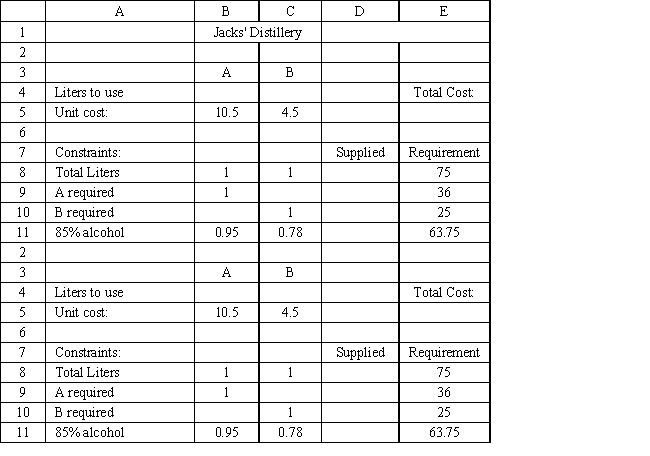Exhibit 3.3
The following questions are based on this problem and accompanying Excel windows.
Jack's distillery blends scotches for local bars and saloons. One of his customers has requested a special blend of scotch targeted as a bar scotch. The customer wants the blend to involve two scotch products, call them A and B. Product A is a higher quality scotch while product B is a cheaper brand. The customer wants to make the claim the blend is closer to high quality than the alternative. The customer wants 50 1500 ml bottles of the blend. Each bottle must contain at least 48% of Product A and at least 500 ml of B. The customer also specified that the blend have an alcohol content of at least 85%. Product A contains 95% alcohol while product B contains 78%. The blend is sold for $12.50 per bottle. Product A costs $7 per liter and product B costs $3 per liter. The company wants to determine the blend that will meet the customer's requirements and maximize profit. 

-Refer to Exhibit 3.3. What formula should be entered in cell D11 in the accompanying Excel spreadsheet to compute the total liters of alcohol supplied?
Definitions:
Competitors
Companies or individuals that engage in rivalry to offer goods or services in the same market, trying to achieve greater sales or market share.
Dominant Firm
Firm with a large share of total sales that sets price to maximize profits, taking into account the supply response of smaller firms.
Demand Curve
Illustrates the relationship between the price of a good or service and the quantity demanded by consumers, typically showing a downward slope.
Fringe Firms
Small companies that operate at the edges of a market, often providing alternative or innovative products compared to mainstream companies.
Q15: The sensitivity analysis provides information about which
Q16: Business analytics focuses on<br>A)identifying and leveraging business
Q19: A factor that plays a role in
Q19: In terms of funds and cash flow
Q19: When a manager considers the effect of
Q22: A company needs to purchase several new
Q25: How many arcs are required to make
Q37: The forecasting model that makes use of
Q41: What is the significance of an absolute
Q58: The main difference between linear LP)and nonlinear